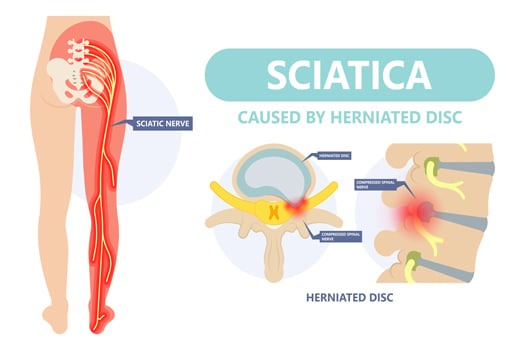
Since the dawn of the new century, spinal surgery has become much more reliable. In fact, it is now considered rare for patients to have serious complications, although success rates vary based on the specific type of surgery. The good news is microdiscectomies have a fairly high success rate. With that being said, some patients still experience issues following surgery. One of these is sciatic pain. This article explains why this may be the case.
The Nerve Is Healing
The sciatic nerve is like any other nerve in the body in that it needs time to heal post-surgery. This is likely to be the case if the nerve was compressed or irritated for a while prior to surgery.
In this case, it is perfectly normal for the nerve to need time to heal after a microdiscectomy. Any discomfort you may be experiencing should naturally subside over time. Part of the reason this happens is because the nerve sometimes sends phantom pain signals along its pathway from the point where it was previously compressed.
The Diagnosis Was Incorrect
Doctors generally tend to make fairly accurate diagnoses. However, there may be times when the actual source of your symptoms is overlooked. Part of the reason this may be the case is if your discomfort has more than one source. For example, the sciatic nerve may be irritated in another place by a different spinal disc. You may also have issues with:
• A spinal joint
• A vertebra that is damaged in a way that causes it to compress the sciatic nerve
• Lumbar radiculopathy
• Piriformis syndrome
• Foraminal and/or central stenosis*
*Narrowing of spinal disc space
Misdiagnosis is not uncommon among spine patients. The main reason is because symptoms of this nature are not always easy to diagnose with absolute accuracy. An MRI scan is usually performed to determine if there is a secondary issue that needs to be addressed to fully resolve the sciatic nerve pain.
You May Have Issues with Scar Tissue
Scar tissue naturally forms after surgery is performed. This protective bodily process is actually a rare cause of sciatic nerve pain following microdiscectomy surgery, since it only grows for about 6–12 weeks post-surgery and it naturally softens over time.
If scar tissue is contributing to your sciatic nerve pain after surgery, it can be broken up naturally with massage therapy or similar techniques in some instances. If those do not work, it may be necessary to have a minor surgical procedure to remove the scar tissue from around the sciatic nerve.
Scar tissue is normal, but, as mentioned above, it is rarely a source of sciatic nerve pain. It is usually only considered a possibility if other potential reasons for your discomfort have been ruled out.
There Are Ways to Manage Post-Surgery Sciatic Nerve Pain
If you have sciatic nerve pain following your microdiscectomy surgery, there are some ways you can successfully manage it or minimize it as much as possible. Common recommendations for how to relieve sciatica pain include:
• Taking medication to manage related inflammation
• Performing physical therapy exercises to strengthen muscles that support your spine and ease pressure on the sciatic nerve
• Making an effort to eat berries, green leafy vegetables, and other foods that naturally fight inflammation
• Using a lumbar support cushion and similar supportive or assistive devices or products that can ease direct pressure on the affected area
• Talking to your doctor to find out for sure if your discomfort is related to a healing sciatic nerve*
*It is often possible to make this determination based on a discussion of your symptoms, since sciatica symptoms are generally fairly unique.
Patients who have had microdiscectomies for herniated discs may experience sciatica if their discs reherniate, which often occurs if there is a large hole in the outer ring of the disc after surgery. Fortunately, there is a new treatment available. Barricaid is a device shown to reduce the risk of reherniation by closing the hole in the disc after a discectomy, and 95 percent of Barricaid patients did not undergo a reoperation due to reherniation in a 2-year study timeframe. This treatment is done immediately following the microdiscectomy—during the same operation—and does not require any additional incisions or time in the hospital.
To learn more about the Barricaid treatment, ask your doctor or contact us at 844-288-7474.
For full benefit/risk information, please visit: https://www.barricaid.com/instructions.


Comments